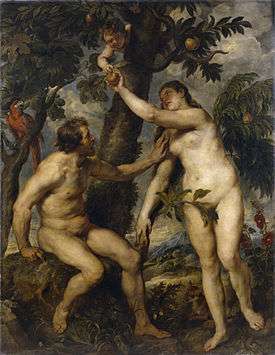Adam and Eve cylinder seal
The Adam and Eve cylinder seal, also known as the 'Temptation seal' is a small stone cylinder of Post-Akkadian origin, dating from about 2200 to 2100 BCE. The seal depicts two seated figures, a tree, and a serpent, and was formerly believed to evince some connection with Adam and Eve from the Book of Genesis; however, this interpretation has been challenged by specialists.
History
Cylinder seals are small cylinders, usually made of stone and pierced from end-to-end. They are designed to be worn on a string or on a pin.
Designs are carved into the surface of cylinders seals in intaglio, so that when rolled on clay, the cylinder leaves a continuous imprint of the design, reversed and in relief. Cylinder seals originate from southern Mesopotamia (now Iraq) or south-western Iran. They were invented around 3500 BC, and were used as an administrative tool, as magical amulets and jewellery and as until around 300 BC. They are linked to the invention of cuneiform writing on clay; when this spread to other areas of the Near East, the use of cylinder seals spread as well.
Assyriologist George Smith (1840–1876) described the Adam and Eve seal as having two figures (male and female) on each side of a tree, holding out their hands to the fruit, while between the backs of the figures is a serpent, giving evidence that the Fall of Man legend was known in early times of Babylonia.[1] [2]
Description
The Adam and Eve cylinder seal is made of greenstone.
According to the British Museum, the seal shows a common scene found on seals from the twenty-third and twenty-second centuries BC: a seated male figure (identified by his head-dress of horns as a god) facing a female worshiper. The date palm and snake between them may merely be symbolic of fertility.[3]
External links
- image, 'Adam and Eve' Cylinder at the British Museum
References
- ↑ Mitchell, T.C. (2004). The Bible in the British Museum : interpreting the evidence (New ed.). New York: Paulist Press. p. 24. ISBN 9780809142927.
- ↑ "Mesopotamian cylinder seals". The British Museum. Retrieved 28 August 2012.
- ↑ "'Adam and Eve' cylinder seal". The British Museum. Archived from the original on 30 April 2011. Retrieved 28 August 2012. (Dead link. Archived version .)
